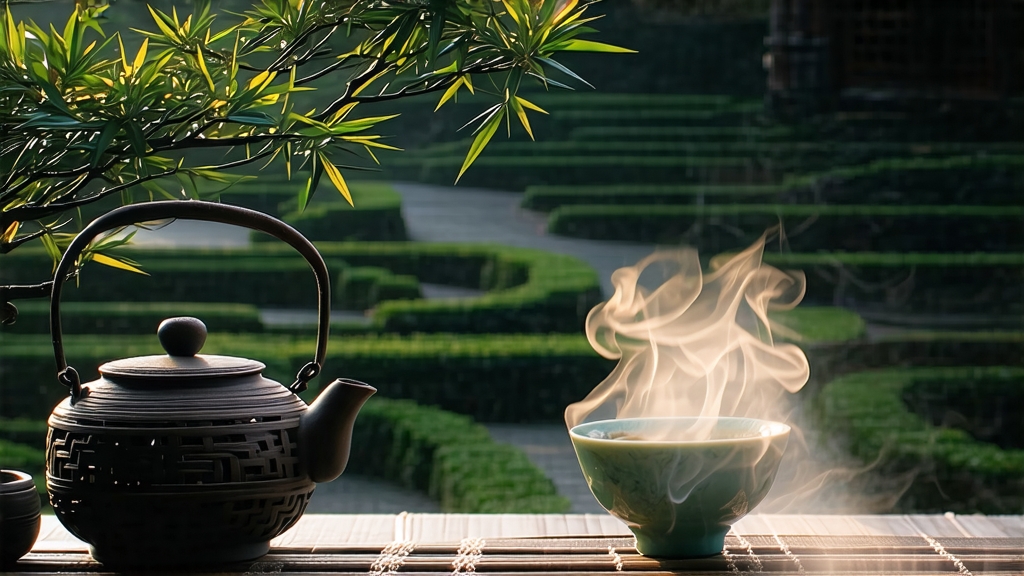
Tieguanyin, literally “Iron Goddess of Mercy,” is the most famous among China’s oolong teas, a living bridge between green freshness and black depth. Born in the granite soils of Anxi County, southern Fujian, its story begins in the early eighteenth century. A humble tea farmer named Wei Yin, so legend says, was directed by Guanyin, the Bodhisattva of Compassion, to a hidden iron statue in the forest. In gratitude he cultivated the wild tea tree beside it, finding the leaves extraordinarily fragrant. Cuttings from that single bush were propagated across the highlands, and the cultivar—now botanically labeled Camellia sinensis var. sinensis ‘Tieguanyin’—became the county’s green gold.
Anxi’s microclimate is the first secret. Morning fog drifts between 300- and 800-metre peaks, slowing photosynthesis and concentrating amino acids. Lateritic granite decomposes into crimson soil rich in potassium and manganese, gifting the leaf a natural minerality that echoes wet river stones. Five flushes are plucked yearly, but the spring and autumn pickings are considered noble; summer sun is too fierce, winter too shy.
Processing Tieguanyin is a choreography of timing and temperature spread across two days and one night. Plucking begins at dawn when two leaves and a half-open bud are still cool. They are spread on bamboo trays to wither under gentle sun for thirty minutes, just long enough for the edges to soften. Then comes the yaoqing—“rocking-green”—the signature shaking that bruises the leaf margins while keeping the veins intact. Masters toss the leaves into a cylindrical bamboo drum that rotates at eighteen revolutions per minute for three-minute bursts, resting them in between to oxidize in piles no thicker than four centimetres. This on-and-off rhythm, repeated six to eight times, oxidizes the leaf edges to 30–50 % while the core stays green, creating the half-ball shape that unfurls like a tiny green heart in hot water.
Fixation follows: leaves are flash-heated in a 230 °C drum for ninety seconds to halt oxidation, locking in a floral lactone bouquet reminiscent of orchid and steamed milk. Rolling is done in two stages—first a mechanical kneading that twists the leaf into a rope, then a cloth-wrapped ball-rolling that compresses it into the characteristic hemispherical “dragonfly head, frog leg” shape. A low-temperature bake at 80 °C for three hours reduces moisture to 4 %, but modern “light aroma” styles receive only a gentle 60 °C bake, preserving jade colour and gardenia notes, whereas the traditional “strong aroma” is charcoal-baked in bamboo baskets over lychee-wood embers for an additional twelve hours, adding chestnut, honey and a whisper of incense.
Tieguanyin is not a single taste but a spectrum. The market now recognises three main stylistic families. Qingxiang (fresh aroma) is the youngest, pale jade liquor, sharp with lily and snap-pea sweetness. Nongxiang (strong aroma) is the nostalgic profile—amber liquor, toasted grain, molasses and a cooling menthol finish that lingers like mint on marble. Chenxiang (aged aroma) is pressed into paper-wrapped bricks and stored in earthen jars for five to thirty years; time oxidises the leaf further, yielding dark mahogany soup, notes of dried longan, sandalwood and the earthy depth of a forest floor after rain. Within each family, micro-lots are distinguished by mountain name—Huangjing, Xianghua, Gande—each terroir adding its own pitch to the melody.
To brew Tieguanyin well, one must listen to the leaf. Begin with a porcelain gaiwan of 100 ml, pre-heated so that a drop of water sizzles away in two seconds. Use 5 g of leaf—about one heaping tablespoon—for a 1:20 ratio. The first infusion is a ritual rinse: water at 95 °C is poured from a height of ten centimetres in a circular motion, then discarded within five seconds to awaken the tightly curled cells. Subsequent steeps are counted in breaths, not minutes. Infuse 15 s, 25 s, 35 s, 50 s, 75 s, adding ten seconds each round until the seventh, when the leaf finally surrenders its last perfume. Throughout